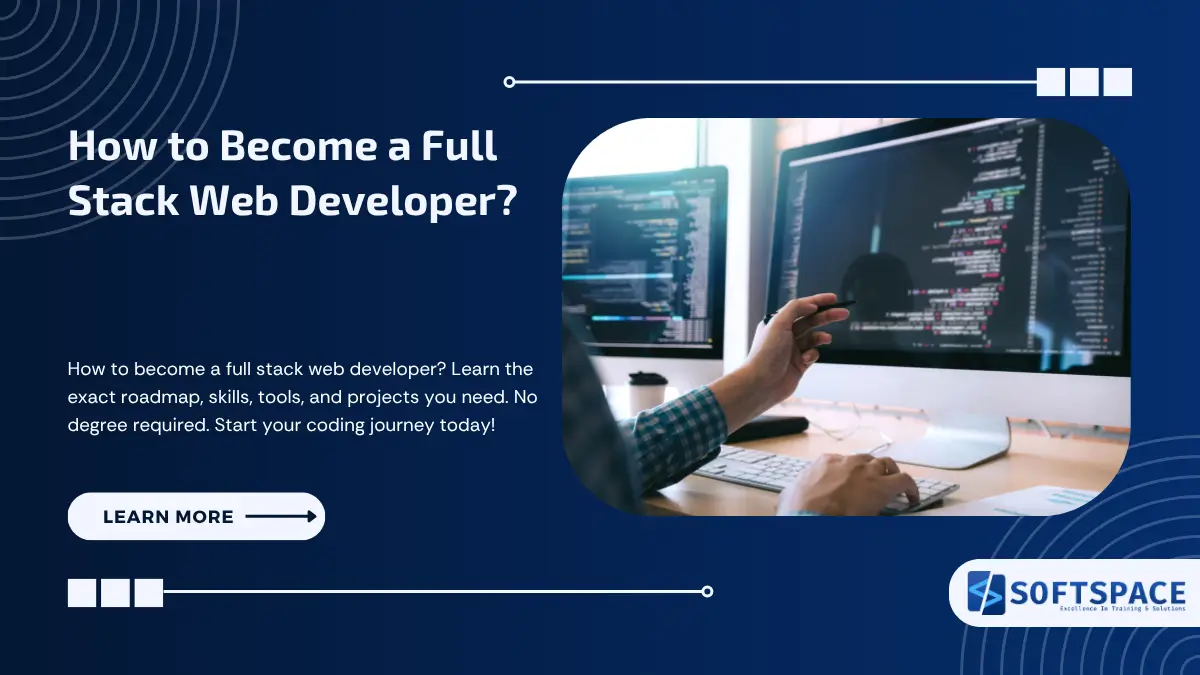If you’re wondering how to become a full stack web developer, you’re not alone. With the growing demand for professionals who can manage both front-end and back-end development, full stack developers are among the most sought-after tech professionals in 2025.
This article will walk you through everything you need to know, from essential skills and tools to learning resources and career opportunities.
What is a Full Stack Web Developer?
A full stack web developer is someone who can work on both the front-end and back-end of web applications. They design and build user interfaces, write server-side logic, manage databases, and deploy complete websites or apps. This versatility makes them highly valuable in the tech industry.
Full stack developers are expected to have a strong understanding of how all parts of a web application work together. Whether it’s designing responsive layouts using CSS or handling server requests and database queries, they are capable of taking a web app from concept to launch.
What Does a Full Stack Web Developer Do?
A Full Stack Web Developer is responsible for designing, developing, and maintaining both the front-end (client side) and back-end (server side) of web applications, covering the entire technology stack from user interfaces to server logic and databases.
Key duties include:
- Frontend Development: Creating user interfaces with HTML, CSS, JavaScript, and frameworks like React, Angular, or Vue.js to ensure responsive, user-friendly web pages.
- Backend Development: Writing server-side logic using languages such as Node.js, Python, Ruby, Java, or PHP, developing and integrating APIs to connect front-end with back-end services.
- Database Management: Designing, managing, and optimising databases (MySQL, PostgreSQL, MongoDB, etc.) and implementing caching for performance.
- Version Control & Collaboration: Using Git for version control, working in agile teams, and coordinating with designers and product managers.
- Deployment & Maintenance: Handling continuous integration/deployment (CI/CD), monitoring app performance, troubleshooting bugs, and updating software after deployment.
Additional roles include testing software responsiveness, ensuring security practices, producing documentation, and staying updated with evolving technologies.
In summary, a full stack developer manages every layer of a web application’s architecture, from the user-facing front end to server infrastructure and databases, enabling seamless, scalable, and maintainable web products.
Top Combinations in Full Stack Development (2025)
Full stack development in 2025 continues to evolve rapidly, combining established frameworks with the latest trends like AI, cloud computing, and modular architectures. Here’s a snapshot of the most sought-after stack combinations and trends shaping the industry.
Noteworthy Trends & Combinations
- JavaScript Everywhere: Mastery of JavaScript frameworks (React, Angular, Vue, Svelte), with TypeScript now a near-essential skill for maintainability and scalability. Backend: Node.js, NestJS, Deno seeing rapid adoption .
- Cloud-Native & DevOps Integration: Skills in Docker, Kubernetes, CI/CD tools (GitHub Actions, Jenkins, CircleCI) and platforms like AWS, Azure, Google Cloud are a must for deployment and scale .
- Real-Time and AI Integration: Increasing focus on serverless, WebSockets, GraphQL, and the integration of AI-powered workflows or assistants in web applications .
- Database Versatility: Developers need flexible skills, SQL (MySQL, PostgreSQL) and NoSQL (MongoDB, Cassandra), plus distributed and cloud-hosted DBs for scalability .
- Emerging Stacks: JAMstack (static+dynamic combo), GoLang+HTMX+TailwindCSS (for high productivity), and modular, AI-enhanced stacks are rising trends.
- Low-Code/No-Code: More companies experiment with these platforms, especially for prototyping and rapid internal tools.
What’s Essential Across All Combinations?
- Version Control: Git proficiency for all collaboration.
- API Development: RESTful and GraphQL APIs as a constant.
- Security & Performance: Built-in with frameworks, but developers must understand core principles.
Today’s full stack developer stacks cover everything from “traditional” LAMP for content-heavy sites to agile JavaScript-based architectures like MERN, and blend in new layers such as AI and cloud services for modern app requirements
Why Should You Become a Full Stack Developer?
- High demand across startups and large companies
- Competitive salaries and freelancing opportunities
- Control over complete projects – from design to deployment
- Flexibility to switch roles (front-end, back-end, or full stack)
- Fast-track career growth – Full stack developers are often promoted to tech leads
According to Naukri and LinkedIn job listings, full stack developers continue to be among the top 5 in-demand IT roles in India. Companies prefer hiring full stack developers to save costs and ensure project continuity across the stack.
How to Become a Full Stack Web Developer in 2025 With Proper Skills?
Front-End Development
Front-end is the user-facing part of the application. You’ll need:
- HTML5 – The structure of your webpages
- CSS3 – Styling and layouts (Flexbox, Grid, Responsive Design)
- JavaScript (ES6+) – Adding interactivity and client-side logic
- Frameworks/Libraries: React.js (most popular), Angular, or Vue.js
- Responsive design: Using frameworks like Bootstrap or Tailwind CSS
Back-End Development
Back-end handles the logic, data, and integration:
- Languages: Node.js (JavaScript), Python, PHP, Java
- Frameworks: Express.js (Node), Django (Python), Laravel (PHP), Spring Boot (Java)
- Concepts: REST APIs, MVC architecture, routing, authentication, authorisation
Databases and Tools
You need to be comfortable working with:
- SQL databases: MySQL, PostgreSQL – used for structured data
- NoSQL databases: MongoDB – flexible schema and scalability
- Version Control: Git for tracking code changes, GitHub for collaboration
- Essential tools: Postman for API testing, VS Code for coding, Docker for containerisation
Additional Skills
- Basic DevOps: CI/CD pipelines, environment management
- Testing: Unit testing (Jest, Mocha), integration testing
- Soft Skills: Communication, problem-solving, collaboration with cross-functional teams
How Long Does It Take to Become a Full Stack Developer?
It typically takes 6 to 12 months with regular learning and practice, depending on your background and time commitment.
Can You Become a Full Stack Developer Without a Degree?
Yes, you can become a Full Stack Developer without a degree. Many succeed through self-learning, coding bootcamps, and building real projects.
Employers often value skills and portfolios over formal education. Focus on mastering front-end (HTML, CSS, JavaScript), back-end (Node.js, Python), databases, and Git. Consistency and practical experience are key to breaking into the field.
Roadmap to Becoming a Full Stack Web Developer
Follow this learning path step-by-step:
- Start with Web Basics: HTML, CSS, JavaScript (master the fundamentals)
- Responsive Design: Learn how to make your website mobile-friendly
- Pick a JS Framework: React is beginner-friendly and widely used
- Version Control: Learn Git commands and how to push/pull from GitHub
- Back-End Basics: Start with Node.js + Express or Python + Django
- Database Skills: Understand CRUD operations, joins, and indexing
- Authentication: Use JWT or OAuth for login systems
- API Development: Create and consume RESTful APIs
- Deployment: Host your projects on Vercel, Heroku, or AWS
- Build Projects: Apply your skills in real-world projects (see examples below)
What Are Some Good Full Stack Projects for Beginners?
- To-do App: CRUD operations with React and Node.js
- Blog Platform: User auth, post creation, comments
- E-commerce Store: Product listing, cart system, admin dashboard
- Portfolio Website: Showcase your resume, skills, and GitHub projects
Best Learning Resources for Full Stack Development (2025)
How to become a Full Stack Web Developer in 2025 by yourself? To start with, SELF STUDY. Explore the course, the languages involved and your logic building expertise. Understand the complexities involved and whether this suits your learning and working interests or not.
Top Online Courses & Bootcamps
- IBM Full Stack Software Developer (Coursera)
Covers front-end, back-end, DevOps, and cloud-native skills. Highly rated for beginners and aspiring professionals. - The Complete 2025 Web Development Bootcamp (Udemy, Dr. Angela Yu)
Comprehensive stack (HTML, CSS, JS, React, Node, SQL, RESTful APIs) with over 60 hours of self-paced content and hands-on projects. - Full Stack Developer Course with Placement (Internshala, India)
Job-focused, includes live classes, hands-on projects, and a certificate with placement assurance. - MIT xPRO Full-Stack Development with MERN Certificate
Advanced, project-based program specialising in the MERN stack (MongoDB, Express, React, Node). - The Odin Project
Free and open-source curriculum that is widely praised for its project-based approach, strong community, and career-oriented roadmap. - GeeksforGeeks: Full Stack Developer Roadmap
Comprehensive portal offering tutorials, quizzes, coding challenges, and up-to-date roadmaps. - freeCodeCamp
Offers free, self-paced, hands-on full stack curriculum focusing on projects and certifications. Especially valued for JavaScript, React, and APIs.
Must-Read Books
Essential Guides & Roadmaps
- roadmap.sh:
Visual and community-driven roadmaps, guides, best practices, and journeys for front-end, back-end, and full-stack developers. Over 300,000 GitHub stars. - Full Stack Development Roadmap 2025 + eBook
A structured, project-driven guide with step-by-step lessons and architecture patterns for modern stacks.
Core Tool and Reference Sites
- MDN Web Docs: The canonical reference for HTML, CSS, and JavaScript.
- JavaScript.info: In-depth JavaScript concepts with interactive examples.
- GitHub: Explore trending open-source full stack projects and code samples.
- Stack Overflow & Reddit: For community support and troubleshooting.
Community & Practice
- Discord and Reddit Groups: Large, active communities to discuss problems, share portfolios, and get feedback.
- GeeksforGeeks, LeetCode, Hackerrank: Platforms for coding practice and interview preparation.
What Is the Average Salary of a Full Stack Developer in India?
Additional insights:
- Salaries tend to be higher in metro tech hubs like Bengaluru, Hyderabad, and Mumbai, with senior devs earning ₹15L to ₹25L+ annually there.
- Skill specialisation (e.g., MERN stack, Java full stack) and certifications can further boost pay.
- Company size and type affect compensation, with MNCs and startups offering different packages including bonuses and stock options.
- The market trend shows continuous salary growth due to rising demand and digitisation in India, with average salaries increasing from ₹6.2L in 2023 to approx ₹8.8L in 2025.
Is Full Stack Development Good for Freelancing?
Yes, full stack development is well-suited for freelancing due to its broad skill set covering both front-end and back-end, which many clients and projects require.
Freelance full stack developers can command competitive rates, typically between $60 and $80 per hour, with flexibility to choose projects and clients according to their preferences.
Freelancing also allows a flexible schedule and can be a stepping stone to full-time roles or a way to phase out from them
Can You Get a Remote Job as a Full Stack Developer?
Yes, remote jobs for full stack developers are widely available and growing, especially as remote work becomes more prevalent in tech.
Key skills demanded include proficiency in JavaScript, HTML, CSS (88% of employers require these), and frameworks like React or Angular, plus backend knowledge in Node.js or Ruby on Rails (61% of postings demand these).
Strong communication skills are crucial, with 70% of managers emphasising their importance for remote collaboration.
How Do You Stay Updated as a Full Stack Developer?
Full stack developers stay updated primarily by:
- Regularly engaging in online courses and tutorials.
- Participating in active developer communities like Stack Overflow, GitHub, Reddit, and LinkedIn groups.
- Attending industry conferences, workshops, and virtual meetups.
- Following technical blogs, newsletters, and podcasts tailored to development trends.
- Building real projects and experimenting with new tools in personal “playground” repositories.
- Focusing on core, enduring concepts, JavaScript, API design, and databases, while being flexible to adapt to new frameworks and technologies.
Consistency and adaptability are key; learning daily, even in small portions (15-20 minutes), helps maintain relevance and growth.
These practices are supported by the fact that cloud computing skills (like AWS, Azure) are increasingly valuable, potentially raising earning potential by up to 30%.

13+ Yrs Experienced Career Counsellor & Skill Development Trainer | Educator | Digital & Content Strategist. Helping freshers and graduates make sound career choices through practical consultation. Guest faculty and Digital Marketing trainer working on building a skill development brand in Softspace Solutions. A passionate writer in core technical topics related to career growth.

